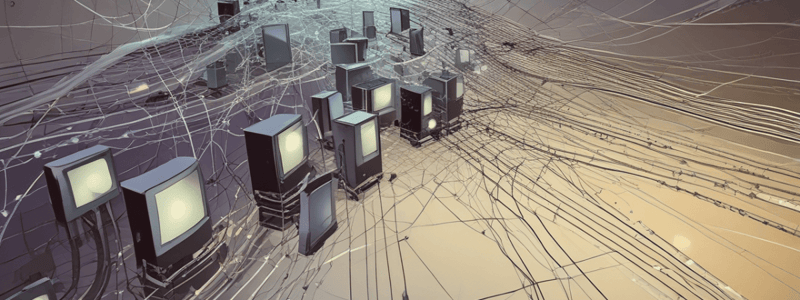Podcast
Questions and Answers
What is the primary function of a routed protocol like IPv4 or IPv6?
What is the primary function of a routed protocol like IPv4 or IPv6?
- To enable dynamic routing protocols to advertise network reachability
- To make forwarding decisions based on layer 3 information (correct)
- To provide a mapping of layer 2 addresses to layer 3 addresses
- To allow routers to share routes and network information
What is the result of running a dynamic routing protocol on routers?
What is the result of running a dynamic routing protocol on routers?
- Routers can only advertise directly connected networks
- Routers can only share secrets with each other
- Routers can only communicate with each other using IPv6
- Routers can become friends and share routes and network information (correct)
What does the 'C' stand for in a routing table?
What does the 'C' stand for in a routing table?
- Computed
- Configured
- Cached
- Connected (correct)
What is the purpose of a routing table?
What is the purpose of a routing table?
What does a routed protocol have in its IP packets?
What does a routed protocol have in its IP packets?
What type of devices have a routing table?
What type of devices have a routing table?
What addressing information does a router use to make forwarding decisions?
What addressing information does a router use to make forwarding decisions?
What command is used to display the routing table on a Cisco router?
What command is used to display the routing table on a Cisco router?
What is the primary function of the control plane in IP routing?
What is the primary function of the control plane in IP routing?
What is the benefit of using a dynamic routing protocol?
What is the benefit of using a dynamic routing protocol?
What is required for a router to forward a packet to a destination network?
What is required for a router to forward a packet to a destination network?
What information does a routing table contain?
What information does a routing table contain?
What happens by default when a router is brought up out of the box and plugged in?
What happens by default when a router is brought up out of the box and plugged in?
How do routers make forwarding decisions?
How do routers make forwarding decisions?
What is an example of a routed protocol?
What is an example of a routed protocol?
What is the purpose of the control plane in routing?
What is the purpose of the control plane in routing?
What information is used to determine the 'street' in a network?
What information is used to determine the 'street' in a network?
What is the purpose of the forwarding decision in IP routing?
What is the purpose of the forwarding decision in IP routing?
What is the primary function of the data plane in a router?
What is the primary function of the data plane in a router?
What is the main purpose of the control plane in a router?
What is the main purpose of the control plane in a router?
What is an example of a directly connected network for a router?
What is an example of a directly connected network for a router?
What is a static route used for in a router?
What is a static route used for in a router?
What is the main advantage of using a dynamic routing protocol over static routes?
What is the main advantage of using a dynamic routing protocol over static routes?
What is the purpose of a multilayer switch in the context of packet forwarding?
What is the purpose of a multilayer switch in the context of packet forwarding?
What is an example of a non-local network for a router?
What is an example of a non-local network for a router?
What is the primary function of the control plane in a router, in analogy to a person's education?
What is the primary function of the control plane in a router, in analogy to a person's education?
What is the main difference between a static route and a dynamic routing protocol?
What is the main difference between a static route and a dynamic routing protocol?
What is the primary purpose of a router's interfaces in the context of packet forwarding?
What is the primary purpose of a router's interfaces in the context of packet forwarding?
What type of device is shown in the video, which has a routing table and is connected to the 10.0.1 network?
What type of device is shown in the video, which has a routing table and is connected to the 10.0.1 network?
What is the purpose of a routing table in a Layer 3 router?
What is the purpose of a routing table in a Layer 3 router?
What command is used on a Windows computer to show the routing table?
What command is used on a Windows computer to show the routing table?
What type of route is indicated by the code 'C' in the routing table?
What type of route is indicated by the code 'C' in the routing table?
What is the purpose of dynamic routing protocols?
What is the purpose of dynamic routing protocols?
What are the three basic methods for a router or firewall to learn how to reach a network?
What are the three basic methods for a router or firewall to learn how to reach a network?
What type of device is shown in the video, which has a routing table and is a next-generation firewall?
What type of device is shown in the video, which has a routing table and is a next-generation firewall?
What is the purpose of a routing table in a device doing IP routing?
What is the purpose of a routing table in a device doing IP routing?
Flashcards are hidden until you start studying
Study Notes
IP Routing Overview
- A routed protocol is a protocol that has layer 3 information used for making forwarding decisions (e.g., IPv4 and IPv6)
- In IP routing, a router needs to learn how to forward packets to reach various networks
Control Plane and Data Plane
- The control plane is the "how to do something" part, where a router learns how to forward packets
- The data plane is the actual forwarding of packets, where a router makes forwarding decisions based on the control plane
Ways to Learn about Networks
-
Directly Connected Networks: A router can learn about networks it is directly connected to
-
Static Routes: A router can be manually configured with static routes to learn about non-local networks
-
Dynamic Routing Protocols: A router can use dynamic routing protocols (e.g., RIP, BGP, OSPF) to learn about networks from other routers
Dynamic routing protocols are like the GPS for routers. Just as GPS helps you find the best route to your destination by checking traffic and other conditions, dynamic routing protocols help routers determine the best paths to send data across a network.
Here's a little more detail about the ones mentioned:
1. RIP (Routing Information Protocol): Think of RIP like a simple GPS that updates its map every 30 seconds and marks the route as good if it's the shortest in terms of hops (or stops). It’s been around for a long time and is easy to set up, but it’s not always the fastest or most efficient.
2. BGP (Border Gateway Protocol): Now, imagine a super-smart GPS that not only knows all the roads but also understands the most important ones for major highways. BGP is mostly used on the internet, connecting different networks together, and it can manage a huge amount of data. It's very complex but very powerful for large networks.
3. OSPF (Open Shortest Path First): This is like a GPS that constantly looks at all possible routes and picks the quickest one based on real-time traffic conditions. OSPF is used mostly within large organizations' own internal networks and keeps updated maps so data gets from point A to point B as quickly and efficiently as possible.
BGP (Border Gateway Protocol) and OSPF (Open Shortest Path First) are both routing protocols, but they serve different purposes and operate in distinct ways.
BGP is like a super-smart GPS for the entire internet. It connects large networks together and is used primarily to route data between different organizations' networks. BGP handles a massive amount of data and is essential for ensuring that information travels efficiently between different countries, ISPs, and major hubs on the internet.
OSPF, on the other hand, is like a GPS for a single organization. It operates within a company's internal network, constantly checking and updating its maps to find the quickest way for data to travel from one point to another within that organization. OSPF ensures that all internal data traffic is managed quickly and efficiently, adapting to real-time conditions.
In essence, BGP manages the global traffic between separate networks, while OSPF optimizes the internal traffic within a single network.
In essence, these protocols help routers communicate with each other to find the best paths for sending data, ensuring your messages, emails, or web pages get where they need to go efficiently and reliably.
Routing Table
- A routing table is like a map or GPS system that stores information on how to forward packets
- A router consults the routing table to make forwarding decisions
- Devices on IP networks, including routers, firewalls, and computers, have routing tables
Examples of Routing Tables
- Router 2: directly connected to 10.12.0 and 10.23.0 networks
- PC1: directly connected to 10.1.0 network
- Windows computer: has routes to various networks, including a default route
- Palo Alto firewall: has routes to directly connected networks and virtual routers
Studying That Suits You
Use AI to generate personalized quizzes and flashcards to suit your learning preferences.




